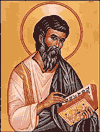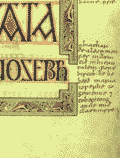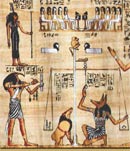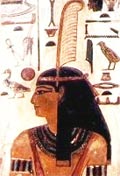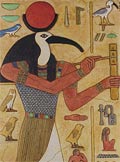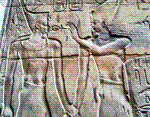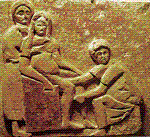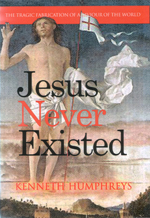He who has ears – Let him hear!
5-minute enlightenment for those in a hurry
Matthew – or maybe not.
Holy Sandwich ...
"Matthew prefaces Mark with the genealogy and the story of the birth and early childhood of Jesus, and supplements it with an account of the resurrection of Jesus and his apparition to his disciples."
– Geza Vermes (The Changing Faces of Jesus, p161).
Cut and Paste ...
Marginal notes added to page of Matthew (7th century Lindisfarne Gospels)
Where Did They Get Their Ideas From?
Plagiarist 'Matthew' plundered Old Testament scripture for almost every chapter of his novel.
1.23 (Isaiah 7.14)
2.6 (Micah 5.2)
2.16,18 (Jeremiah 31.15)
2.14,15 (Hosea 11.1)
2.23 (Judges 13.5)
3.3 (Isaiah 40.3)
4.4 (Deuteronomy 8.3)
4.7 (Deuteronomy 6.16)
4.10 (Deuteronomy 6.13)
4.6 (Psalm 91.11,12)
4.16 (Isaiah 9.1,2)
5.21 (Exodus 20.13)
5.27 (Exodus 20.14)
5.31 (Deuteronomy 24.1)
5.38 (Exodus 21.24)
5.43 (Leviticus 19.18)
6.11 (Proverbs 30.8)
6.12 (Ecclesiasticus 28.2)
8.17 (Isaiah 53.4)
9.13 (Hosea 6.6)
10.35,6 (Micah 7.6)
11.10 (Malachi 3.1)
12.7 (Hosea 6.6)
12.18,21 (Isaiah 42.1,4)
13.14,15 (Isaiah 6.9,10)
13.35 (Psalm 78.2)
15.4 (Exodus 20.12, 21.17)
15.8,9 (Isaiah 29.13)
18.16 (Deuteronomy 19.15)
19.4 (Genesis 1.27)
19.5 (Genesis 2.24)
19.18,19 (Exodus 20.12,16)
21.5 (Zechariah 9.9)
21.9 (Psalm 118.26)
21.13 (Jeremiah 7.11)
21.16 (Psalm 8.2)
21.42 (Psalm 118.22,23)
22.32 (Exodus 3.6)
22.39 (Leviticus 19.18)
22.37 (Deuteronomy 6.5)
22.44 (Psalm 110.1)
23.39 (Psalm 118.26)
24.15 (Daniel 9.27)
24.29 (Isaiah 13.10; 34.4)
26.31 (Zechariah 13.7)
27.10 (Zechariah 11.12,13)
27.35 (Psalm 22.18)
27.46 (Psalm 22.1)
Adventure story, says bishop
"Matthew takes a virgin birth tradition and fits it into a biblical annunciation pattern – combined with a popular narrative in which the story of Jesus and Joseph is modelled on the adventures of the patriarch Joseph and the infant Moses."
– Bishop J.S. Spong (Born of a Woman)
Cut and Paste ...
"Matthew ... has been through the scriptures cheerfully lifting details, and then inventing the 'facts' to fit the 'prophesies'. Micah said that the Messiah would be born in Bethlehem, so Jesus finds himself, most improbable for a Galilean, being born in Bethlehem."
– A. N. Wilson (Jesus, p62)
Cut and Paste ...
"The practice which the writers of these books employ is not more false than it is absurd. They state some trifling case of the person they call Jesus Christ, and then cut out a sentence from some passage of the Old Testament and call it a prophecy of that case.
But when the words thus cut out are restored to the place they are taken from, and read with the words before and after them, they give the lie to the New Testament."
– Thomas Paine
Cut and Paste ...
"St Paul evidently knew nothing of such a remarkable occurrence as a virgin birth, for he never mentions any such thing – which he surely would have had it been part of his faith ... The author of Matthew's Gospel, keen as ever to show that Jesus prophecies have been fulfilled, picks up this verse [Isaiah 7.14 from the Septuagint] and applies it to Jesus."
– Daphne Hampson (After Christianity, p49)
A Professor Speaks..
"Matthew's story of the Massacre of the Innocents by Herod the Great ... is a myth allegedly fulfilling a prophecy by Jeremiah...
It is mentioned, strangely enough, neither in the Old Testament nor by the Jewish historian Josephus, nor by the Talmud."
– Michael Grant (Jesus, p71,2)
Oops. A Prophesy that Failed
Here is a prophecy that didn't fit into the Christian revamp:
"Behold, the days come, saith the LORD, that I will raise unto David a righteous Branch, and a King shall reign and prosper, and shall execute judgment and justice in the earth.
In his days Judah shall be saved, and Israel shall dwell safely: and this is his name whereby he shall be called, The LORD Our Righteousness."
– Jeremiah 23.5,6.
The prophet says nothing about an expected king requiring 2 visits to Earth, separated by thousands of years, in order to accomplish what was expected of him.
Author?
"And as Jesus passed forth from thence, he saw a man, named Matthew, sitting at the receipt of custom: and he saith unto him, Follow me. And he arose, and followed him."
– Matthew 9.9.
Or was it really Maat?
The central drama of the Egyptian Book of the Dead was the weighing of the heart against truth – represented by an ostrich feather, the maat or mati. Recording the result was Tehuti or Taht better known by the Greek name Thoth, scribe of the gods.
Personified, Maat became the wife of Thoth and wore the feather. The chief judge in an Egyptian law court (the Hall of Maat) was known as a "priest of Ma'at".
Inspired “sayings” of Horus the Lord were recorded by Taht-Mati, the scribe (representing both male and female deities).
From sacred Egyptian lore "Sayings of the Lord according to Mati" passed into Christianity via the lost Gospel of the Egyptians, re-emerging as the "Gospel of Matthew."
A Professor Speaks..
"We are led inescapably to this conclusion: that the awesomely influential Nativity story in the first book of the New Testament is a speculative, rather than a historical text.
Far from being a report of a literal happening, it is an amalgam of flawed Greek-Christian scriptural references, and of "birth tales" current in Judaism in the first century AD.
The story with which we are all so familiar is not fact, but folklore."
– Géza Vermes, The Daily Telegraph, 19.12.2004
Last Word: Matthew makes Jesus a Trinitarian
Matthew's gospel would have closed with some of his disciples worshipping him but others – yes, even some of his chosen band – "doubting" !
A thoughtful scribe added a much more upbeat message, endorsing the notion of the Trinity.
"And Jesus came, and spoke to them, saying, All power is given to me in heaven and in earth.
Go therefore, and teach all nations, baptizing them in the name of the Father, and of the Son, and of the Holy Ghost, teaching them to observe all things whatsoever I have commanded you: and, lo, I am with you alway, even unto the end of the world."
– Matthew 28.18-20.
* "Mark" an abridgement?
The alternative theory, still favoured by fundamentalists and conservatives but otherwise discarded, is that Mark is an abridged version of Matthew.
But:-
• Why on earth would Mark delete such crucial events as the nativity or the post-death appearances?
• Why would Mark discard most of the parables and the teachings, including the Sermon on the Mount and even details of the crucifixion?
• Why would Mark degrade the language and make clear passages opaque?
It is untenable theory for multiple reasons.
|
The Gospel of Matthew is an expanded version of the Gospel of Mark.* Almost all the story elements, phrases and words used by Mark – about ninety-five per cent of them – are regurgitated in Matthew. But the Markan core has been refined by the later writer with extra detail, explanatory clauses and improved adjectives. The gospel has gained an extra eight thousand words. "Difficult" passages have been improved upon. Thus, for example, where Mark tells briefly of a freshly baptized Jesus, tempted in the wilderness by Satan, Matthew illustrates that temptation with three examples: taunts of bread from stones, falling from the temple pinnacle, and a gift of the world. Each example is drawn – not from history! – but from Jewish scripture (Deuteronomy and Psalms). But why rewrite Mark at all? Matthew is writing later. The Second Coming has not materialized, the Jews have suffered a second catastrophic defeat at the hands of Rome, and the Marcionites were already circulating an early version of Luke, diluting the Jewishness of the divine mission. Matthew will put the Jesus train back onto its Jewish tracks.
From Righteous man to Demigod Matthew's main contributions to the Jesus tale are stories of the divine nature, shown most acutely in the birth and postmortem appearances. The righteous man of Mark's tale, chosen by God for the infusion of the holy spirit at his adult baptism, has been promoted to a demigod from birth. The snippets of human emotion and foibles found in Mark (anger, tiredness, amazement, grief, etc) are downplayed or erased. On the other hand, a raft of purported prophecies, gleaned from across Jewish scripture, have been marshalled by Matthew as proof texts that the hero of his gospel fulfills all the expectations of the sages and is a unique Son of God. Indeed, in Matthew's reworking, the Jewish prophets have been vindicated. Jesus himself emphasizes the Jewishness of his mission: it is to "fulfil the Law" (Matthew 5.17), not its Pauline abolition. The twelve disciples, representative of the Jewish people, often dull-witted in Mark and told by Jesus they will "serve not rule" (Mark 10.37-45), are given an improved status. They will "sit in judgement of Israel on twelve thrones" (Matthew 19.28). Mark's simple tale had the form of a holy play but after Matthew's redaction, the work has become an instructional text, making the whole less suitable for street theatre but appropriate for use in heretical synagogues. Jesus now speaks long sermons (notably, On the Mount) and performs miracles for didactic purpose.
An incorrigible plagiarist "makes
the best of it"
In the aftermath of that devastating conflict, a Greek-speaking Jew, writing in the pagan city of Antioch, had been at pains to reassure the Roman authorities that his particular faith posed no threat to the imperium. The writer had fled 'fundamentalist' Jerusalem for the relative enlightenment of the pagan city of Antioch. He had with him an early version of 'Mark' and used this as the basis for his own story. His creation would eventually become known as 'Matthew.' He wrote for a Jewish audience, one still close to the ancestral faith. He thus has his hero say:
At this point, the Christ story acquired the first of two (contradictory!) genealogies. Though "son of the creator god", and presumably not really needing an earthly pedigree at all, Jesus none the less acquired a surrogate father, Joseph, and a lineage back to King David. Again, none of this is to be found in Paul’s writings but Paul is now dead. In order to meet traditional Jewish expectations that the messiah would arise from the "House of David" the writer prefaced Mark's baptism story with an impressive genealogy. The author of Matthew also tried to tidy up the embarrassing theology of Jesus’s baptism by the "sinner" John the Baptist, by adding a "rationale", absent from Mark:
But establishing a bona fides claim to messianic hopes of the Jews had to go hand-in-hand with toadying to Rome. Thus the writer rehashes the story of Pharaoh’s murder of male babies (found in Exodus 1.15,22) into Herod’s murder of male babies. Since Herod had died in 4 BC and the supposed Jesus had not been "born" until the governorship of Quinirius (beginning in 6 AD) the validity of this mass murder is questionable, even before one considers the total absence of historical evidence. Yet the point was to blacken the Jewish priesthood (Christ-killers and baby- killers!) and distance Paulite Christians from them.
Copies his own calling?! "Matthew", purportedly chosen by the godman as one of his intimate band of acolytes, even copies the story of his own calling, word-for-word, from the testimony of "Mark", erstwhile travelling companion of St Paul and a non-witness to the holy melodrama! The only difference is that Mark calls his publican (tax collector) Levi son of Alphaeus not Matthew. Confusingly, later in his yarn, the author of Mark names Matthew as one of the twelve and not Levi. He also decides that it is a James who is "son of Alphaeus" (Mark 3.18). The authors of Luke and Matthew both agree that it is James who is a son of Alphaeus (Luke 6.15; Matthew 10.3) and not Levi. In fact, Matthew fails to mention a Levi at all. Oh well, it is all fiction.
"Fulfilling Prophecy"? – An easy trick when you rewrite both 'prophecy' and its 'fulfillment'!
Matthew's task was to tease out new interpretations of the old scripture – wrenching his references completely out of context in fact – and juxtapositioning these "quotations" with some pithy incident in the Jesus biography which he is fabricating. How can he get away with this duplicity? Because fortunately for 'Matthew' he was writing in Greek for a Greek-speaking audience, most of whom had no direct familiarity with Hebrew scripture but relied – if on any other source at all – on the Greek translation, the Septuagint. Matthew even misquotes freely from this secondhand source to serve his own purposes. Faking the prophecy of a Virgin Birth: Famously, Matthew maintains that 'Isaiah' had prophesied that Jesus would be born of a virgin:
The Hebrew original says: 'Hinneh ha-almah harah ve-yeldeth ben ve-karath shem-o immanuel.' Honestly translated, the verse reads: 'Behold, the young woman has conceived — and bears a son and calls his name Immanuel.' The slip did not matter at the time, for in context, Isaiah’s prophecy (set in the 8th century BC but probably written in the 5th century BC) had been given as reassurance to King Ahaz of Judah that his royal line would survive, despite the ongoing siege of Jerusalem by the Syrians. And it did. In other words, the prophecy had nothing to do with events in Judaea eight hundred years into the future! Yet upon this doctored verse from Isaiah the deceitful scribe who wrote Matthew was to concoct the infamous prophecy that somehow the ancient Jewish text had presaged the miraculous birth of the Christian godman.
Faking a prophecy of the city of birth: The 8th century BC Jewish sage 'Micah' writes about Assyrian invaders and a series of skirmishes in Samaria. He predicts (quite incorrectly as it turns out) that a ruler will arise from David's Bethlehem and conquer Assyria. What does Micah actually say? The Massoretic (Hebrew) text of Micah 5.2, translated, says:
Undeterred, Matthew subtly alters the quoted text in his own story (2.6):
Faking a prophecy of the hero's hometown: The writer of Matthew started the deceit that the title 'Jesus the Nazarene' should in some manner relate to Nazareth, by quoting 'prophecy':
Faking a reason for the trip to Egypt: Only Matthew tells the story of the holy family rushing off to Egypt to escape the murderous intent of Herod the Great. And yet Herod was a firmly established ruler who skillfully stayed on the winning side at Rome over four decades. He also had full-grown male heirs to succeed him. The notion that Herod would be "afraid" that the baby of an obscure Nazareth carpenter would supplant him is laughable. According to Luke the blessed trio returned immediately to Nazareth without any concern for the wrath of the Jewish king. But the Egyptian connection is vital to Matthew's purposes – he has in mind a literary vignette in which Herod plays the part of "Pharaoh", infants are killed, and "Israel" (="Jesus") is rescued. Matthew this time quotes the venerable "Hosea", though without giving his source:
Faking a prophecy of Herod's (fictional) 'Massacre of the Innocents': Here Matthew switches his source to 'Jeremiah', whose commentary is actually on the 6th century BC Babylonian captivity. At verse 31.15 the oracle says:
So cavalier is Matthew with his 'quotations' from the prophets that he even wrongly attributes one quote: in referring to Judas's "thirty pieces of silver" (27.3,10) he maintains that the prophecy of 'Jeremiah' had been fulfilled – and yet it is 'Zechariah' (11.12-13) who used the phrase!
Faking an Ass prophecy: Matthew (21.4,5) throws in another "prophecy" from 'Zechariah' that the King will arrive at Jerusalem mounted on an ass (and actually misreads the quotation and brings along a colt as well!) Zechariah actually says:
Rise And Shine Having bulked out Mark's story of the god-man with "ancient prophecy" – in other words, with the "evidence" that would convince Jews who still had faith in the prophets – Matthew writes an altogether more exciting ending to the sacred biography. The god-man's death is the catalyst for severe earthquake, the rising of many corpses that go off to Jerusalem (!!), guards on the tomb (an idea copied from Joshua), and a snowy white angel sitting on a tombstone. This angel instructs Mary Magdalene and the "other Mary" to quickly tell the disciples of the risen god-man, though before they can do so, JC himself puts in an appearance and repeats the instruction. Unlike in Mark, the women are ecstatic with joy, not filled with fear; and Jesus promises the disciples to be with them "always". Significantly, Matthew devotes rather fewer words to the fabulous resurrection than to rebutting the idea that the disciples had simply stolen the body – a tale obviously popular among the Jews when the fable was written ("This saying has been spread abroad among the Jews up to this very day" – 28.15). No doubt his keenness to add the "miraculous birth" preface had a similar motivation – to rebut Jewish slurs that if the Christian god-man had been born to an unmarried mother it was pretty scandalous origin.
Priestly Discourse Matthew groups
the main body of his fable into five chunks of priestly instruction,
each ending with the same formula – "Now when Jesus
had finished these words ..." (7.28;11.1;13.53;19.1.26.1).
Each discourse emphasizes in some way the role of the Church in
inheriting the promised 'Kingdom'.
Sources:
Copyright © 2004
by Kenneth Humphreys. |
||||||||||||||||||||||||||||||||||||||||||||||||||||||||||||||||||||||||||||
